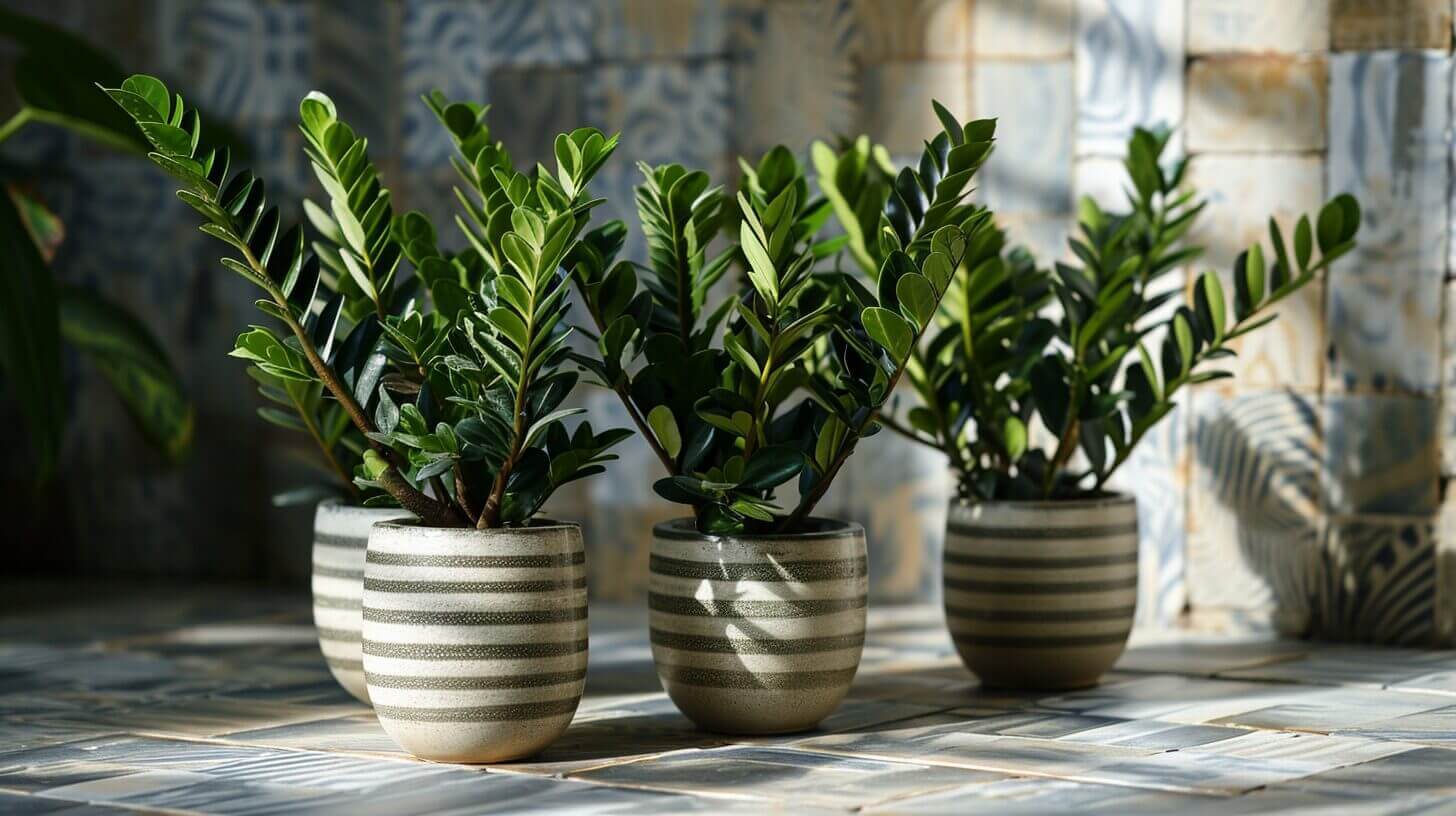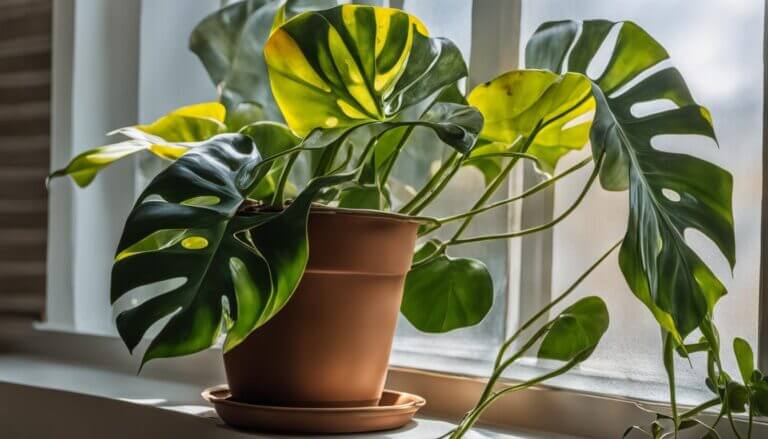Does A ZZ Plant Need Direct Sunlight? ZZ Plant Light Requirements Tips For Healthy Plants
Are you tired of playing guessing games with your ZZ plant’s lighting needs? Look no further!
In this article, we debunk the myth that ZZ plants thrive on direct sunlight and provide you with expert lighting tips for maintaining their health.
Whether you’re a seasoned plant parent or just starting your green journey, we’ve got you covered.
Discover the secrets to creating the perfect lighting conditions for your ZZ plant and ensure its well-being with our practical advice.
Key Takeaways
- ZZ plants thrive in low light conditions but require 4-6 hours of bright, indirect light per day.
- Direct sunlight should be avoided, as it can cause leaf scorching and overexposure.
- Place ZZ plants near a north or east-facing window to ensure they receive adequate indirect sunlight.
- If natural light is not available, artificial lighting options such as fluorescent or LED lights can be used to supplement the light needs of ZZ plants.
Understanding ZZ Plant Light Requirements
To ensure optimal growth and health of ZZ plants, it is crucial to understand the specific lighting requirements, including the ideal duration and intensity of light exposure.
ZZ plants are known for their ability to thrive in low light conditions, making them an excellent choice for indoor spaces with limited access to natural sunlight. However, it is important to provide them with the right amount of light to promote growth and prevent any potential issues.
ZZ plants prefer bright, indirect light for around 4-6 hours a day. They can tolerate some direct sunlight, but it is best to avoid placing them in intense, full sun as it can scorch their leaves. It is recommended to place your ZZ plant near a north or east-facing window where it can receive indirect sunlight throughout the day. If natural light is not available, you can use artificial lighting such as fluorescent or LED lights to meet their lighting needs.
It is important to note that ZZ plants can adapt to various lighting conditions, but too little or too much light can have adverse effects on their growth. Insufficient light can lead to stunted growth and pale leaves, while excessive light can cause leaf burn and damage.
Therefore, finding the right balance is key to maintaining the health and vibrancy of your ZZ plant.
The Importance of Indirect Sunlight for ZZ Plants
How does indirect sunlight contribute to the overall health and vitality of ZZ plants? Understanding the growth patterns of ZZ plants and avoiding common mistakes in ZZ plant care are essential for their well-being.
Here are three reasons why indirect sunlight is crucial for the health and vitality of ZZ plants:
- Prevents leaf scorching: ZZ plants have naturally glossy leaves, which can easily scorch under direct sunlight. Indirect sunlight provides a gentle and diffused light that prevents leaf damage and ensures the plant’s overall health.
- Ensures balanced growth: ZZ plants have a unique growth pattern where they produce new stems and leaves from underground rhizomes. Indirect sunlight allows for a balanced growth of both the underground rhizomes and the above-ground foliage, resulting in a healthier and more vibrant plant.
- Avoids overexposure: ZZ plants are native to shaded areas in Africa, where they thrive under indirect sunlight. Exposing them to direct sunlight can lead to overexposure and cause the plant to become stressed or even die. By providing indirect sunlight, you create an environment that mimics their natural habitat, promoting optimal growth and vitality.
Understanding the importance of indirect sunlight in ZZ plant care is crucial for their overall health and vitality. By avoiding direct sunlight and providing a suitable lighting environment, you can ensure the long-term well-being of your ZZ plants.
How to Identify the Right Amount of Light for Your ZZ Plant
During the process of identifying the right amount of light for your ZZ plant, it is important to carefully observe and assess the plant’s response to different lighting conditions over a period of time. Identifying optimal lighting conditions for your ZZ plant is crucial for its growth and overall health. ZZ plants are known for their ability to tolerate low light conditions, making them a popular choice for indoor spaces. However, they still require sufficient light to thrive.
Signs of insufficient light include slower growth, smaller leaves, and a leggy appearance. If your ZZ plant is not receiving enough light, you may need to move it to a spot with brighter indirect light or consider using artificial grow lights.
On the other hand, excessive light can also be detrimental to ZZ plants. Signs of excessive light include yellowing or browning of leaves, scorched or burned patches on the leaves, and stunted growth. If your ZZ plant is exposed to too much direct sunlight, it is important to move it to a spot with more shade or use a sheer curtain to filter the light.
Factors That Can Affect the Lighting Needs of ZZ Plants
One factor that significantly affects the lighting needs of ZZ plants is the distance between the plant and the light source. The closer the plant is to the light source, the more intense the lighting it receives. On the other hand, if the plant is too far away, it may not receive enough light for proper growth. It is important to find the right balance and adjust the lighting conditions accordingly.
Factors affecting lighting needs of ZZ plants:
- Intensity of light: ZZ plants prefer bright, indirect light. Direct sunlight can be too harsh and may scorch the leaves. It is recommended to place the plant in a well-lit room with filtered sunlight.
- Duration of light exposure: ZZ plants require a certain amount of darkness to rest and rejuvenate. It is important to provide them with a consistent lighting schedule, allowing them to have 12-14 hours of darkness each day.
- Light spectrum: Different light sources emit different spectrums of light. ZZ plants thrive under a combination of cool and warm light. Using a combination of fluorescent and LED lights can provide the optimal spectrum for healthy growth.
Adjusting lighting conditions for ZZ plants can ensure their well-being and promote lush, vibrant foliage. By considering these factors, you can create an ideal environment for your ZZ plant to thrive.
Tips for Providing Adequate Lighting to Keep Your ZZ Plant Healthy
Proper lighting is essential for maintaining the health of your ZZ plant, and implementing adequate lighting techniques can ensure optimal growth and vitality of the plant. While direct sunlight can be beneficial for some plants, ZZ plants prefer indirect light and can suffer from overexposure to direct sunlight. To provide the right lighting conditions for your ZZ plant, you can consider using artificial lighting options for indoor plants. These artificial lights can mimic natural sunlight and provide the necessary light intensity and spectrum for the plant’s growth.
To prevent overexposure to direct sunlight, it is important to place your ZZ plant in a location where it receives bright, indirect light. Direct sunlight can cause the leaves of the ZZ plant to burn and turn yellow. If you have a south-facing window, it is advisable to use a sheer curtain or blinds to filter the sunlight and create a diffused light environment for your plant.
Here is a comparison of different lighting options for indoor ZZ plants:
| Light Source | Light Intensity | Light Spectrum |
|---|---|---|
| Natural sunlight | High | Full spectrum of colors |
| Fluorescent lights | Medium | Limited spectrum |
| LED lights | High | Customizable spectrum |
Frequently Asked Questions
When Should I Repot My ZZ Plant Based on Its Light Requirements?
To keep your zz plant healthy, it’s important to consider its light requirements when deciding on repotting. If your ZZ plant is receiving too much direct light, repotting it into a larger container with fresh soil can help provide some shade. On the other hand, if it’s lacking sufficient light, repotting may not be necessary, and instead, you can find a suitable spot with more indirect sunlight. Monitoring your plant’s light needs is key to maintaining its health.
Can I Place My ZZ Plant in a Room With No Windows?
Placing a ZZ plant in a room with no windows may not provide sufficient lighting for its growth.
ZZ plants typically require bright, indirect sunlight to thrive.
However, if natural sunlight is unavailable, alternative lighting sources such as fluorescent or LED grow lights can be used to provide the necessary light for the plant.
It is important to ensure that the lighting is consistent and adequate for the ZZ plant’s needs to maintain its health and vitality.
Do ZZ Plants Grow Better Under Artificial Light?
The growth rate of ZZ plants under artificial lighting is a topic of interest for many plant enthusiasts. Utilizing artificial light sources for ZZ plant growth offers several benefits.
Firstly, artificial lighting can provide a consistent and controlled light intensity, ensuring optimal conditions for plant growth.
Secondly, it allows for flexibility in plant placement, as ZZ plants can thrive in rooms with no windows.
Lastly, artificial lighting can supplement natural light, ensuring that the plant receives adequate light for healthy growth.
Can I Place My ZZ Plant Outside in Direct Sunlight?
The suitability of placing a ZZ plant outside in direct sunlight depends on several factors. ZZ plants are known for their ability to thrive in low-light conditions, making them popular indoor plants. However, they can tolerate some indirect sunlight if gradually acclimated to outdoor conditions.
It is important to monitor the plant closely and provide appropriate care, such as regular watering and protection from extreme temperatures. Ultimately, understanding the specific needs of your ZZ plant will help ensure its health and vitality in different lighting conditions.
How much light does ZZ plant need?
A ZZ plant needs as much bright, filtered light as possible. However, it can survive in a wide range of lighting conditions, including low light.
Can a ZZ plant survive without light?
While ZZ plants can tolerate low light levels, they won’t thrive without any light at all. They need some level of light to photosynthesize and grow.
What happens if my ZZ plant gets too much light?
If your ZZ plant is getting too much light, its leaves may start to yellow or brown. If you notice this, consider moving the plant away from the light source.
How often should I water my ZZ plant?
You should water your ZZ plants once the soil dries out completely. Overwatering can lead to root rot and other issues.
Can a ZZ plant survive with just artificial light?
Yes, a ZZ plant can survive with artificial light. They are quite adaptable and can tolerate a wide range of lighting conditions.
What are the light requirements for a ZZ plant?
ZZ plants prefer bright, indirect light but can tolerate low light conditions. They should be kept out of direct sunlight as it can scorch their leaves.
How do I know if my ZZ plant is getting enough light?
If your ZZ plant is healthy and growing, it’s likely getting enough light. Signs of insufficient light can include slow growth and yellowing leaves.
Can a ZZ plant be kept in a room without windows?
While a ZZ plant can tolerate low light conditions, it still needs some light to survive. In a room without windows, you may need to provide artificial light.
Can a ZZ Plant Thrive Without Direct Sunlight?
Can a ZZ plant thrive without direct sunlight? Yes, it can. ZZ plants have low zz plant light requirements and can tolerate low-light conditions. They are known for their ability to survive in indirect sunlight, making them an ideal choice for indoor spaces with minimal natural light. This hardy plant can adapt to various lighting conditions, but it’s important to avoid placing it in direct sunlight, as it can scorch the leaves.
How do I care for a ZZ plant?
Caring for a ZZ plant involves providing it with the right amount of light and water. They prefer bright, indirect light and should be watered when the soil is dry.
What happens if I don’t water my ZZ plant enough?
If you don’t water your ZZ plant enough, it may start to wilt or its leaves may turn brown. However, ZZ plants are quite drought-tolerant and can survive periods of under-wateringZZ plants have lowes-a-zz-plant-need-direct-sunlight-lighting-tips-for-healthy-plants”>Does A ZZ Plant Need Direct Sunlight? ZZ Plant Light Requirements Tips For Healthy Plants
Are you tired of playing guessing games with your ZZ plant’s lighting needs? Look no further!
In this article, we debunk the myth that ZZ plants thrive on direct sunlight and provide you with expert lighting tips for maintaining their health.
Whether you’re a seasoned plant parent or just starting your green journey, we’ve got you covered.
Discover the secrets to creating the perfect lighting conditions for your ZZ plant and ensure its well-being with our practical advice.
Key Takeaways
- ZZ plants thrive in low light conditions but require 4-6 hours of bright, indirect light per day.
- Direct sunlight should be avoided, as it can cause leaf scorching and overexposure.
- Place ZZ plants near a north or east-facing window to ensure they receive adequate indirect sunlight.
- If natural light is not available, artificial lighting options such as fluorescent or LED lights can be used to supplement the light needs of ZZ plants.
Understanding ZZ Plant Light Requirements
To ensure optimal growth and health of ZZ plants, it is crucial to understand the specific lighting requirements, including the ideal duration and intensity of light exposure.
ZZ plants are known for their ability to thrive in low light conditions, making them an excellent choice for indoor spaces with limited access to natural sunlight. However, it is important to provide them with the right amount of light to promote growth and prevent any potential issues.
ZZ plants prefer bright, indirect light for around 4-6 hours a day. They can tolerate some direct sunlight, but it is best to avoid placing them in intense, full sun as it can scorch their leaves. It is recommended to place your ZZ plant near a north or east-facing window where it can receive indirect sunlight throughout the day. If natural light is not available, you can use artificial lighting such as fluorescent or LED lights to meet their lighting needs.
It is important to note that ZZ plants can adapt to various lighting conditions, but too little or too much light can have adverse effects on their growth. Insufficient light can lead to stunted growth and pale leaves, while excessive light can cause leaf burn and damage.
Therefore, finding the right balance is key to maintaining the health and vibrancy of your ZZ plant.
The Importance of Indirect Sunlight for ZZ Plants
How does indirect sunlight contribute to the overall health and vitality of ZZ plants? Understanding the growth patterns of ZZ plants and avoiding common mistakes in ZZ plant care are essential for their well-being.
Here are three reasons why indirect sunlight is crucial for the health and vitality of ZZ plants:
- Prevents leaf scorching: ZZ plants have naturally glossy leaves, which can easily scorch under direct sunlight. Indirect sunlight provides a gentle and diffused light that prevents leaf damage and ensures the plant’s overall health.
- Ensures balanced growth: ZZ plants have a unique growth pattern where they produce new stems and leaves from underground rhizomes. Indirect sunlight allows for a balanced growth of both the underground rhizomes and the above-ground foliage, resulting in a healthier and more vibrant plant.
- Avoids overexposure: ZZ plants are native to shaded areas in Africa, where they thrive under indirect sunlight. Exposing them to direct sunlight can lead to overexposure and cause the plant to become stressed or even die. By providing indirect sunlight, you create an environment that mimics their natural habitat, promoting optimal growth and vitality.
Understanding the importance of indirect sunlight in ZZ plant care is crucial for their overall health and vitality. By avoiding direct sunlight and providing a suitable lighting environment, you can ensure the long-term well-being of your ZZ plants.
How to Identify the Right Amount of Light for Your ZZ Plant
During the process of identifying the right amount of light for your ZZ plant, it is important to carefully observe and assess the plant’s response to different lighting conditions over a period of time. Identifying optimal lighting conditions for your ZZ plant is crucial for its growth and overall health. ZZ plants are known for their ability to tolerate low light conditions, making them a popular choice for indoor spaces. However, they still require sufficient light to thrive.
Signs of insufficient light include slower growth, smaller leaves, and a leggy appearance. If your ZZ plant is not receiving enough light, you may need to move it to a spot with brighter indirect light or consider using artificial grow lights.
On the other hand, excessive light can also be detrimental to ZZ plants. Signs of excessive light include yellowing or browning of leaves, scorched or burned patches on the leaves, and stunted growth. If your ZZ plant is exposed to too much direct sunlight, it is important to move it to a spot with more shade or use a sheer curtain to filter the light.
Factors That Can Affect the Lighting Needs of ZZ Plants
One factor that significantly affects the lighting needs of ZZ plants is the distance between the plant and the light source. The closer the plant is to the light source, the more intense the lighting it receives. On the other hand, if the plant is too far away, it may not receive enough light for proper growth. It is important to find the right balance and adjust the lighting conditions accordingly.
Factors affecting lighting needs of ZZ plants:
- Intensity of light: ZZ plants prefer bright, indirect light. Direct sunlight can be too harsh and may scorch the leaves. It is recommended to place the plant in a well-lit room with filtered sunlight.
- Duration of light exposure: ZZ plants require a certain amount of darkness to rest and rejuvenate. It is important to provide them with a consistent lighting schedule, allowing them to have 12-14 hours of darkness each day.
- Light spectrum: Different light sources emit different spectrums of light. ZZ plants thrive under a combination of cool and warm light. Using a combination of fluorescent and LED lights can provide the optimal spectrum for healthy growth.
Adjusting lighting conditions for ZZ plants can ensure their well-being and promote lush, vibrant foliage. By considering these factors, you can create an ideal environment for your ZZ plant to thrive.
Tips for Providing Adequate Lighting to Keep Your ZZ Plant Healthy
Proper lighting is essential for maintaining the health of your ZZ plant, and implementing adequate lighting techniques can ensure optimal growth and vitality of the plant. While direct sunlight can be beneficial for some plants, ZZ plants prefer indirect light and can suffer from overexposure to direct sunlight. To provide the right lighting conditions for your ZZ plant, you can consider using artificial lighting options for indoor plants. These artificial lights can mimic natural sunlight and provide the necessary light intensity and spectrum for the plant’s growth.
To prevent overexposure to direct sunlight, it is important to place your ZZ plant in a location where it receives bright, indirect light. Direct sunlight can cause the leaves of the ZZ plant to burn and turn yellow. If you have a south-facing window, it is advisable to use a sheer curtain or blinds to filter the sunlight and create a diffused light environment for your plant.
Here is a comparison of different lighting options for indoor ZZ plants:
| Light Source | Light Intensity | Light Spectrum |
|---|---|---|
| Natural sunlight | High | Full spectrum of colors |
| Fluorescent lights | Medium | Limited spectrum |
| LED lights | High | Customizable spectrum |
Frequently Asked Questions
When Should I Repot My ZZ Plant Based on Its Light Requirements?
To keep your zz plant healthy, it’s important to consider its light requirements when deciding on repotting. If your ZZ plant is receiving too much direct light, repotting it into a larger container with fresh soil can help provide some shade. On the other hand, if it’s lacking sufficient light, repotting may not be necessary, and instead, you can find a suitable spot with more indirect sunlight. Monitoring your plant’s light needs is key to maintaining its health.
Can I Place My ZZ Plant in a Room With No Windows?
Placing a ZZ plant in a room with no windows may not provide sufficient lighting for its growth.
ZZ plants typically require bright, indirect sunlight to thrive.
However, if natural sunlight is unavailable, alternative lighting sources such as fluorescent or LED grow lights can be used to provide the necessary light for the plant.
It is important to ensure that the lighting is consistent and adequate for the ZZ plant’s needs to maintain its health and vitality.
Do ZZ Plants Grow Better Under Artificial Light?
The growth rate of ZZ plants under artificial lighting is a topic of interest for many plant enthusiasts. Utilizing artificial light sources for ZZ plant growth offers several benefits.
Firstly, artificial lighting can provide a consistent and controlled light intensity, ensuring optimal conditions for plant growth.
Secondly, it allows for flexibility in plant placement, as ZZ plants can thrive in rooms with no windows.
Lastly, artificial lighting can supplement natural light, ensuring that the plant receives adequate light for healthy growth.
Can I Place My ZZ Plant Outside in Direct Sunlight?
The suitability of placing a ZZ plant outside in direct sunlight depends on several factors. ZZ plants are known for their ability to thrive in low-light conditions, making them popular indoor plants. However, they can tolerate some indirect sunlight if gradually acclimated to outdoor conditions.
It is important to monitor the plant closely and provide appropriate care, such as regular watering and protection from extreme temperatures. Ultimately, understanding the specific needs of your ZZ plant will help ensure its health and vitality in different lighting conditions.
How much light does ZZ plant need?
A ZZ plant needs as much bright, filtered light as possible. However, it can survive in a wide range of lighting conditions, including low light.
Can a ZZ plant survive without light?
While ZZ plants can tolerate low light levels, they won’t thrive without any light at all. They need some level of light to photosynthesize and grow.
What happens if my ZZ plant gets too much light?
If your ZZ plant is getting too much light, its leaves may start to yellow or brown. If you notice this, consider moving the plant away from the light source.
How often should I water my ZZ plant?
You should water your ZZ plants once the soil dries out completely. Overwatering can lead to root rot and other issues.
Can a ZZ plant survive with just artificial light?
Yes, a ZZ plant can survive with artificial light. They are quite adaptable and can tolerate a wide range of lighting conditions.
What are the light requirements for a ZZ plant?
ZZ plants prefer bright, indirect light but can tolerate low light conditions. They should be kept out of direct sunlight as it can scorch their leaves.
How do I know if my ZZ plant is getting enough light?
If your ZZ plant is healthy and growing, it’s likely getting enough light. Signs of insufficient light can include slow growth and yellowing leaves.
Can a ZZ plant be kept in a room without windows?
While a ZZ plant can tolerate low light conditions, it still needs some light to survive. In a room without windows, you may need to provide artificial light.
Can a ZZ Plant Thrive Without Direct Sunlight?
Can a ZZ plant thrive without direct sunlight? Yes, it can. ZZ plants have low zz plant light requirements and can tolerate low-light conditions. They are known for their ability to survive in indirect sunlight, making them an ideal choice for indoor spaces with minimal natural light. This hardy plant can adapt to various lighting conditions, but it’s important to avoid placing it in direct sunlight, as it can scorch the leaves.
How do I care for a ZZ plant?
Caring for a ZZ plant involves providing it with the right amount of light and water. They prefer bright, indirect light and should be watered when the soil is dry.
What happens if I don’t water my ZZ plant enough?
If you don’t water your ZZ plant enough, it may start to wilt or its leaves may turn brown. However, ZZ plants are quite drought-tolerant and can survive periods of under-watering.







